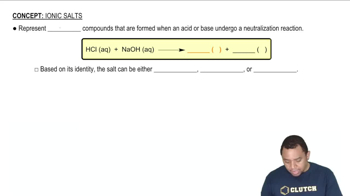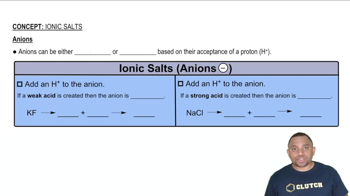Here are the essential concepts you must grasp in order to answer the question correctly.
Salt Hydrolysis
Salt hydrolysis refers to the reaction of a salt with water, leading to the formation of acidic or basic solutions. When a salt dissolves in water, its constituent ions can interact with water molecules, potentially altering the pH of the solution. The nature of the ions—whether they are derived from a strong acid or base—determines if the solution will be neutral, acidic, or basic.
Recommended video:
Acidic and Basic Ions
In the context of salt solutions, acidic ions (like Fe³⁺ from Fe(NO₃)₃) can donate protons to water, forming hydronium ions (H₃O⁺) and lowering the pH, while basic ions (like NO₃⁻) do not affect the pH significantly. Understanding the properties of these ions is crucial for predicting the behavior of the salt in solution and determining whether the resulting solution is acidic, basic, or neutral.
Recommended video:
Anion Acidity and Basicity
Equilibrium Constants
Equilibrium constants (K) are numerical values that describe the ratio of products to reactants at equilibrium for a given reaction. In the context of acid-base chemistry, the equilibrium constants for dissociation reactions help predict the extent to which a salt will hydrolyze in water. By consulting equilibrium constants, one can assess the strength of the acids or bases formed from the salt's ions, aiding in the classification of the solution's pH.
Recommended video:
 Verified step by step guidance
Verified step by step guidance


